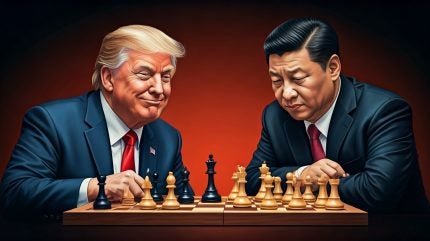
In a bold move that underscores rising tensions between the world’s two largest economies, China has released an official government video signalling that it will not yield to tariff threats from the United States.
(Watch the video at the end of this article.)
The dramatic message comes as the Trump administration tempers its language but continues to push ahead with aggressive trade measures, raising fears of a long-lasting geopolitical standoff.
Despite a recent shift in tone from Washington, Beijing has responded with uncompromising rhetoric and firm resistance, both diplomatically and economically.
With elections on the horizon in the US and economic pressure mounting in China, neither side appears willing to take the first step towards de-escalation.
China rejects diplomacy on us terms

US Tariffs are shifting - will you react or anticipate?
Don’t let policy changes catch you off guard. Stay proactive with real-time data and expert analysis.
By GlobalDataWhile the US insists the next move lies with China, Chinese officials have rejected any suggestion that talks are underway or even possible under current conditions. Beijing has made it clear that negotiations will not resume unless all existing tariffs are removed and both countries engage on equal terms.
At a BRICS meeting in Brazil, Chinese Foreign Minister Wang Yi accused the United States of using trade as a weapon. “The US, which has long benefited enormously from free trade, is now going so far as to use tariffs as a bargaining chip to demand exorbitant prices from all countries,” Wang said.
“If one chooses to remain silent, compromise and cower, it will only make the bully want to push his luck more.”
He urged fellow emerging-market nations to resist what he described as “economic intimidation”, and warned that appeasement would only embolden Washington.
Public support fuels China’s defiance
The release of the video is part of a wider campaign by China to project strength both at home and abroad.
The Foreign Ministry’s video—featuring bilingual subtitles and patriotic imagery—declares that China will not be intimidated and vows to hold firm, no matter the economic cost. It is as much a signal to the Chinese public as it is to the international community.
According to reporting from Bloomberg, the rising nationalist sentiment in China is working in favour of President Xi Jinping, who has used the trade dispute to rally domestic support and strengthen the Communist Party’s narrative of resilience.
Analysts suggest that far from weakening Beijing’s resolve, the Trump administration’s tariff campaign may be hardening it.
The video’s tone, echoing the language used at the BRICS summit, frames China as a principled actor standing up to unilateralism and coercion—messages likely to resonate with citizens and sympathetic governments alike.
Economic measures to weather the storm
Despite its firm stance, Beijing is not ignoring the economic toll of the dispute. Nearly a third of China’s growth last year came from exports, many of which are now threatened by American tariffs.
On Monday, Chinese officials pledged support for affected exporters, promising easier access to credit, targeted stimulus, and potential interest rate cuts.
These efforts form part of a broader strategy to reduce dependence on US trade and “Trump-proof” the Chinese economy. The government is encouraging domestic consumption, exploring alternative export markets, and ensuring that vulnerable firms—particularly small manufacturers—have the financial tools to survive a prolonged trade war.
China has also denied claims by US officials that private discussions are taking place behind closed doors. Instead, Beijing continues to demand mutual respect and a fundamental reset in the terms of engagement before any real progress can be made.
An impasse with global implications
The trade dispute between the US and China is no longer just about levies on steel, electronics, or soybeans. It has evolved into a test of national resolve, leadership credibility, and competing economic philosophies.
Both governments have placed themselves in positions that are politically difficult to retreat from, especially in front of domestic audiences.
Although the Trump administration has publicly said it wants to avoid escalation, the underlying policy remains one of pressure. White House economic adviser Sarah Bessent stated that the US has “an escalation ladder” and is “anxious not to have to use it”, suggesting that while the language may soften, the strategy is still one of leverage.
With both economies deeply integrated into global supply chains, the consequences of prolonged tension will ripple far beyond Washington and Beijing. Investors, businesses, and foreign governments are watching closely as the rhetoric hardens and diplomatic space narrows.
Whether this video is a final warning or the start of a broader campaign remains unclear. But its message is unmistakable: China has no intention of backing down.
The Chinese Foreign Ministry’s video, released with English and Chinese subtitles, declares China will ‘never yield’ to pressure from the United States:
Watch the full Chinese Foreign Ministry video
Navigate the shifting tariff landscape with real-time data and market-leading analysis. Request a free demo for GlobalData’s Strategic Intelligence here.




